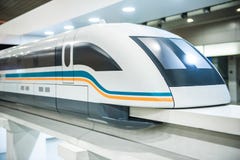Suave
Simulated character
I'd like there to be a magnetic levitation railway system that'd run coast to coast in the U.S. from New York City to Washington D.C., Chicago, St.Louis, Kansas City, Denver, Phoenix, and Los Angeles. Mag-lev trains can travel up to 275 m.p.h. If a train could travel continuously go at this speed, it'd take 12 hours to go from coast to coast via the aforementioned coast to coast route. Mag-lev trains would reduce our nation's carbon foot-priint by reducing carbon fuel emitting airline travel. Based on the construction cost of Shanghai's mag-lev railway system (Edit A), (Reference A): Shanghai maglev train the cost would be approximately 120 million dollars per mile (Edit B) , a 3.200 mile mag-lev railway system should cost nearly $400 billion to build. (Edit C) If this railway system were to accommodate 200,000 passengers per day with each passenger paying on average a fare of merely $150 (Edit D), this would generate $400 billion of revenue over the course of less than 35 years in order to pay off the cost of having this Trans-U.S. Railway system built. (Edit E) There would be many high paying jobs created by having a mag-lev railway system running coast to coast via New York City to Washington D.C., Chicago, St.Louis, Kansas City, Denver, Phoenix, and Los Angeles. In my environmentally friendly opinion, we should build back our nation better with this clean green energy mode of transportation.

Edit A - edited to based on the construction cost Shanghai's mag-lev railway system, edited from based on the cost of mag-lev railway systems built in China and Europe.
Edit B - edited to 120 million dollars per mile from 40 million dollars per mile
Edit C - edited to $400 billion from $128 billion cost to build
Edit D - edited to each passenger paying on average a fare of $150 from each passenger paying on average a fare of $50
Edit E - edited to $400 billion from $128 billion of revenue over the course of less than 35 years in order to pay off the cost of having this Trans-Us Railway system built.
Reference A: Shanghai maglev train

Edit A - edited to based on the construction cost Shanghai's mag-lev railway system, edited from based on the cost of mag-lev railway systems built in China and Europe.
Edit B - edited to 120 million dollars per mile from 40 million dollars per mile
Edit C - edited to $400 billion from $128 billion cost to build
Edit D - edited to each passenger paying on average a fare of $150 from each passenger paying on average a fare of $50
Edit E - edited to $400 billion from $128 billion of revenue over the course of less than 35 years in order to pay off the cost of having this Trans-Us Railway system built.
Reference A: Shanghai maglev train
Last edited:
